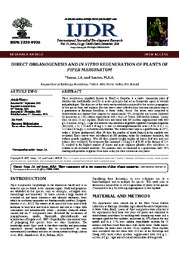Direct organogenesis and in vitro regeneration of plants of Piper marginatum.
Direct organogenesis and in vitro regeneration of plants of Piper marginatum.
Author(s): SOUZA, J. A. de; SANTOS, M. R. A. dos
Summary: Piper marginatum, popularly known in Brazil as Caapeba, is a native Amazonian plant of shrubby size, traditionally used for its active principles that act as therapeutic agents in wounds and pathologies. The objective of this work was to establish a protocol for the in vitro propagation of this species from leaf explants. For this, leaves were collected from two-year-old plants kept in a greenhouse at Embrapa Rondônia, in Porto Velho, Brazil. The leaves were subjected to disinfestation in a laminar flow chamber by immersion in 70% alcohol for one minute, followed by immersion in 2.0% sodium hypochlorite with 1.0 mL of Tween 20® for five minutes. Leaves were cut into 1.0 cm2 explants, which were inoculated into MS medium supplemented with 30.0 g L-1 sucrose, 6.0 g L-1 agar and variable concentrations of growth regulators benzylaminopurine (BA) (0.0, 1.13, 2.25 and 4.50 mg L-1) and 2,4-dichlorophenoxyacetic acid (2,4-D) (0.0, 1.11, 2.21 and 4.42 mg L-1) in factorial combination. The cultures were kept in a growth room at 25°C, under a 16-hour photoperiod. After 30 days, the number of shoots formed in the explants was evaluated. These shoots were subcultured on MS medium, under the conditions described, but without growth regulators. After 60 days, plantlet height, number of leaves, leaf area and root volume were evaluated. The treatment that contained 1.13 mg L-1 of BAP, in the absence of 2,4-D, resulted in the highest number of shoots and more vigorous plantlets after subculture, in relation to all evaluated variables. The plantlets were acclimatized in a greenhouse, with 50% shading and sprinkler irrigation three times a day, for their conversion into plants.
Publication year: 2021
Types of publication: Journal article
Unit: Embrapa Rondônia
Keywords: Caapeba, Cultura In Vitro, Explante, Explants, Folha, Genetic techniques and protocols, In vitro regeneration, Leaves, Medicinal plants, Organogenesis, Organogénese, Piper marginatum, Plant reproduction, Planta Medicinal, Propagação Vegetativa, Protocolo de propagação, Regeneração, Reprodução Vegetal, Vegetative propagation
Observation
Some of Embrapa's publications are published as ePub files. To read them, use or download one of the following free software options to your computer or mobile device. Android: Google Play Books; IOS: iBooks; Windows and Linux: Calibre.
Access other publications
Access the Agricultural Research Database (BDPA) to consult Embrapa's full library collection and records.
Visit Embrapa Bookstore to purchase books and other publications sold by Embrapa.

